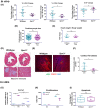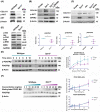Small proline-rich repeat 3 is a novel coordinator of PDGFRβ and integrin β1 crosstalk to augment proliferation and matrix synthesis by cardiac fibroblasts
- PMID: 32297675
- PMCID: PMC7302973
- DOI: 10.1096/fj.201902815R
Small proline-rich repeat 3 is a novel coordinator of PDGFRβ and integrin β1 crosstalk to augment proliferation and matrix synthesis by cardiac fibroblasts
Abstract
Nearly 6 million Americans suffer from heart failure. Increased fibrosis contributes to functional decline of the heart that leads to heart failure. Previously, we identified a mechanosensitive protein, small proline-rich repeat 3 (SPRR3), in vascular smooth muscle cells of atheromas. In this study, we demonstrate SPRR3 expression in cardiac fibroblasts which is induced in activated fibroblasts following pressure-induced heart failure. Sprr3 deletion in mice showed preserved cardiac function and reduced interstitial fibrosis in vivo and reduced fibroblast proliferation and collagen expression in vitro. SPRR3 loss resulted in reduced activation of Akt, FAK, ERK, and p38 signaling pathways, which are coordinately regulated by integrins and growth factors. SPRR3 deletion did not impede integrin-associated functions including cell adhesion, migration, or contraction. SPRR3 loss resulted in reduced activation of PDGFRβ in fibroblasts. This was not due to the reduced PDGFRβ expression levels or decreased binding of the PDGF ligand to PDGFRβ. SPRR3 facilitated the association of integrin β1 with PDGFRβ and subsequently fibroblast proliferation, suggesting a role in PDGFRβ-Integrin synergy. We postulate that SPRR3 may function as a conduit for the coordinated activation of PDGFRβ by integrin β1, leading to augmentation of fibroblast proliferation and matrix synthesis downstream of biomechanical and growth factor signals.
Keywords: collagen; fibrosis; heart failure; pressure overload; transverse aortic constriction.
© 2020 The Authors. The FASEB Journal published by Wiley Periodicals LLC on behalf of Federation of American Societies for Experimental Biology.
Conflict of interest statement
The authors declare no conflict of interest.
Figures






Similar articles
-
Identification of small proline-rich repeat protein 3 as a novel atheroprotective factor that promotes adaptive Akt signaling in vascular smooth muscle cells.Arterioscler Thromb Vasc Biol. 2014 Dec;34(12):2527-36. doi: 10.1161/ATVBAHA.114.303644. Epub 2014 Oct 2. Arterioscler Thromb Vasc Biol. 2014. PMID: 25278290 Free PMC article.
-
Loss of SPRR3 in ApoE-/- mice leads to atheroma vulnerability through Akt dependent and independent effects in VSMCs.PLoS One. 2017 Sep 8;12(9):e0184620. doi: 10.1371/journal.pone.0184620. eCollection 2017. PLoS One. 2017. PMID: 28886156 Free PMC article.
-
Regulation of the atheroma-enriched protein, SPRR3, in vascular smooth muscle cells through cyclic strain is dependent on integrin alpha1beta1/collagen interaction.Am J Pathol. 2008 Nov;173(5):1577-88. doi: 10.2353/ajpath.2008.080042. Epub 2008 Oct 2. Am J Pathol. 2008. PMID: 18832573 Free PMC article.
-
Developmental Pathways of Cardiac Fibroblasts.Cold Spring Harb Perspect Biol. 2020 Apr 1;12(4):a037184. doi: 10.1101/cshperspect.a037184. Cold Spring Harb Perspect Biol. 2020. PMID: 31570334 Free PMC article. Review.
-
A potential role for integrin signaling in mechanoelectrical feedback.Prog Biophys Mol Biol. 2012 Oct-Nov;110(2-3):196-203. doi: 10.1016/j.pbiomolbio.2012.07.002. Epub 2012 Jul 20. Prog Biophys Mol Biol. 2012. PMID: 22819851 Free PMC article. Review.
Cited by
-
Cardiac fibrosis.Cardiovasc Res. 2021 May 25;117(6):1450-1488. doi: 10.1093/cvr/cvaa324. Cardiovasc Res. 2021. PMID: 33135058 Free PMC article. Review.
-
Exploring Integrin α5β1 as a Potential Therapeutic Target for Pulmonary Arterial Hypertension: Insights From Comprehensive Multicenter Preclinical Studies.Circulation. 2025 Apr 22;151(16):1162-1183. doi: 10.1161/CIRCULATIONAHA.124.070693. Epub 2025 Jan 20. Circulation. 2025. PMID: 39829438 Free PMC article.
-
Properties and Functions of Fibroblasts and Myofibroblasts in Myocardial Infarction.Cells. 2022 Apr 20;11(9):1386. doi: 10.3390/cells11091386. Cells. 2022. PMID: 35563692 Free PMC article. Review.
-
Smad7 effects on TGF-β and ErbB2 restrain myofibroblast activation and protect from postinfarction heart failure.J Clin Invest. 2022 Feb 1;132(3):e146926. doi: 10.1172/JCI146926. J Clin Invest. 2022. PMID: 34905511 Free PMC article.
-
Identification of diagnostic model in heart failure with myocardial fibrosis and conduction block by integrated gene co-expression network analysis.BMC Med Genomics. 2024 Feb 14;17(1):52. doi: 10.1186/s12920-024-01814-w. BMC Med Genomics. 2024. PMID: 38355637 Free PMC article.
References
-
- Camelliti P, Borg TK, Kohl P. Structural and functional characterisation of cardiac fibroblasts. Cardiovasc Res. 2005;65:40‐51. - PubMed
Publication types
MeSH terms
Substances
Grants and funding
LinkOut - more resources
Full Text Sources
Molecular Biology Databases
Miscellaneous

